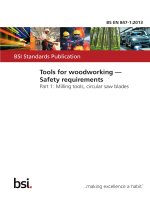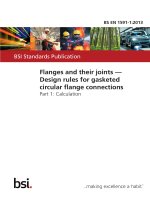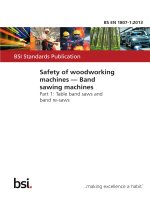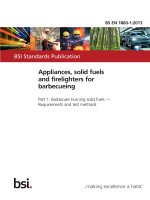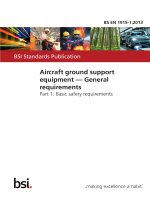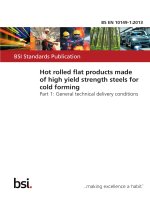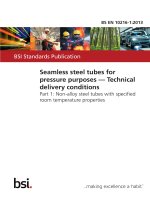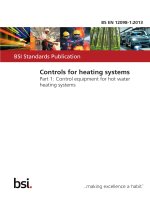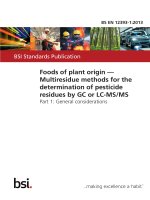Bsi bs en 61499 1 2013
Bạn đang xem bản rút gọn của tài liệu. Xem và tải ngay bản đầy đủ của tài liệu tại đây (1.87 MB, 122 trang )
BS EN 61499-1:2013
BSI Standards Publication
Function blocks
Part 1: Architecture
BS EN 61499-1:2013 BRITISH STANDARD
National foreword
This British Standard is the UK implementation of EN 61499-1:2013. It is
identical to IEC 61499-1:2012. It supersedes BS EN 61499-1:2005 which is
withdrawn.
The UK participation in its preparation was entrusted to Technical Committee
GEL/65, Measurement and control.
A list of organizations represented on this committee can be obtained on
request to its secretary.
This publication does not purport to include all the necessary provisions of a
contract. Users are responsible for its correct application.
© The British Standards Institution 2013
Published by BSI Standards Limited 2013
ISBN 978 0 580 78490 3
ICS 25.040.40; 35.240.50
Compliance with a British Standard cannot confer immunity from
legal obligations.
This British Standard was published under the authority of the Standards
Policy and Strategy Committee on 30 April 2013.
Amendments issued since publication
Amd. No. Date Text affected
EUROPEAN STANDARD BS EN 61499-1:2013
NORME EUROPÉENNE
EUROPÄISCHE NORM EN 61499-1
ICS 25.040; 35.240.50 February 2013 Supersedes EN 61499-1:2005
English version
Function blocks -
Part 1: Architecture
(IEC 61499-1:2012)
Blocs fonctionnels - Funktionsbausteine für industrielle
Partie 1: Architecture Leitsysteme -
(CEI 61499-1:2012) Teil 1: Architektur
(IEC 61499-1:2012)
This European Standard was approved by CENELEC on 2012-12-12. CENELEC members are bound to comply
with the CEN/CENELEC Internal Regulations which stipulate the conditions for giving this European Standard
the status of a national standard without any alteration.
Up-to-date lists and bibliographical references concerning such national standards may be obtained on
application to the CEN-CENELEC Management Centre or to any CENELEC member.
This European Standard exists in three official versions (English, French, German). A version in any other
language made by translation under the responsibility of a CENELEC member into its own language and notified
to the CEN-CENELEC Management Centre has the same status as the official versions.
CENELEC members are the national electrotechnical committees of Austria, Belgium, Bulgaria, Croatia, Cyprus,
the Czech Republic, Denmark, Estonia, Finland, Former Yugoslav Republic of Macedonia, France, Germany,
Greece, Hungary, Iceland, Ireland, Italy, Latvia, Lithuania, Luxembourg, Malta, the Netherlands, Norway, Poland,
Portugal, Romania, Slovakia, Slovenia, Spain, Sweden, Switzerland, Turkey and the United Kingdom.
CENELEC European Committee for Electrotechnical Standardization
Comité Européen de Normalisation Electrotechnique
Europäisches Komitee für Elektrotechnische Normung
Management Centre: Avenue Marnix 17, B - 1000 Brussels
© 2013 CENELEC - All rights of exploitation in any form and by any means reserved worldwide for CENELEC members.
Ref. No. EN 61499-1:2013 E
BS EN 61499-1:2013
EN 61499-1:2013 - 2 -
Foreword
The text of document 65B/845/FDIS, future edition 2 of IEC 61499-1, prepared by SC 65B
"Measurement and control devices" of IEC/TC 65 "Industrial-process measurement, control and
automation" was submitted to the IEC-CENELEC parallel vote and approved by CENELEC as
EN 61499-1:2013.
The following dates are fixed:
• latest date by which the document has (dop) 2013-09-12
to be implemented at national level by (dow) 2015-12-12
publication of an identical national
standard or by endorsement
• latest date by which the national
standards conflicting with the
document have to be withdrawn
This document supersedes EN 61499-1:2005.
EN 61499-1:2013 includes the following significant technical changes with respect to
EN 61499-1:2005:
• Execution control in basic function blocks (5.2) has been clarified and extended:
- dynamic and static parts of the EC transition condition are clearly delineated by using the
ec_transition_event[guard_condition] syntax of the Unified Modeling Language (UML) (5.2.1.3,
B.2.1);
- the terminology "crossing of an EC transition" (3.10) is used preferentially to "clearing" to avoid
the misinterpretation that the entire transition condition corresponds to a Boolean variable that
can be "cleared.";
- operation of the ECC state machine in 5.2.2.2 has been clarified and made more rigorous;
- event and data outputs of adapter instances (plugs and sockets) can be used in EC transition
conditions, and event inputs of adapter instances can be used as EC action outputs.
• Temporary variables (3.97) can be declared (B.2.1) and used in algorithms of basic function blocks.
• Service sequences (6.1.3) can now be defined for basic and composite function block types and
adapter types, as well as service interface types.
• The syntax for mapping of FB instances from applications to resources has been simplified
(Clause B.3).
• Syntax for definition of segment types (7.2.3) for network segments of system configurations has
been added (Clause B.3).
• Function block types for interoperation with programmable controllers are defined (Clause D.6).
• The READ/WRITE management commands (Table 8) now apply only to parameters.
Attention is drawn to the possibility that some of the elements of this document may be the subject of
patent rights. CENELEC [and/or CEN] shall not be held responsible for identifying any or all such
patent rights.
BS EN 61499-1:2013
- 3 - EN 61499-1:2013
Endorsement notice
The text of the International Standard IEC 61499-1:2012 was approved by CENELEC as a European
Standard without any modification.
In the official version, for Bibliography, the following notes have to be added for the standards indicated:
IEC 61131-5:2000 NOTE Harmonised as EN 61131-5:2001 (not modified).
IEC 61499 Series NOTE Harmonised as EN 61499 Series (not modified).
IEC 61499-2:2012 NOTE Harmonised as EN 61499-2:2013 (not modified).
IEC 61499-4 NOTE Harmonised as EN 61499-4.
BS EN 61499-1:2013
EN 61499-1:2013 - 4 -
Annex ZA
(normative)
Normative references to international publications
with their corresponding European publications
The following documents, in whole or in part, are normatively referenced in this document and are
indispensable for its application. For dated references, only the edition cited applies. For undated
references, the latest edition of the referenced document (including any amendments) applies.
NOTE When an international publication has been modified by common modifications, indicated by (mod), the relevant EN/HD
applies.
Publication Year Title EN/HD Year
IEC 61131-1 - Programmable controllers - EN 61131-1 -
IEC 61131-3 2003 Part 1: General information 2003
ISO/IEC 7498-1 1994 -
Programmable controllers - EN 61131-3
ISO/IEC 8824-1 2008 Part 3: Programming languages -
ISO/IEC 10646 2003 Information technology - Open Systems - -
Interconnection - Basic Reference Model:
The Basic Model
Information technology - Abstract Syntax -
Notation One (ASN.1): Specification of basic
notation
Information technology - Universal multiple- -
octet coded character set (UCS)
– 2 – BS EN 61499-1:2013
61499-1 © IEC:2012
CONTENTS
INTRODUCTION ..................................................................................................................... 7
1 Scope...............................................................................................................................8
2 Normative references .......................................................................................................8
3 Terms and definitions .......................................................................................................9
4 Reference models .......................................................................................................... 18
4.1 System model........................................................................................................ 18
4.2 Device model ........................................................................................................ 19
4.3 Resource model .................................................................................................... 19
4.4 Application model .................................................................................................. 21
4.5 Function block model............................................................................................. 21
4.5.1 Characteristics of function block instances ................................................21
4.5.2 Function block type specifications ............................................................. 23
4.5.3 Execution model for basic function blocks .................................................23
4.6 Distribution model ................................................................................................. 25
4.7 Management model ............................................................................................... 25
4.8 Operational state models.......................................................................................27
5 Specification of function block, subapplication and adapter interface types.....................27
5.1 Overview ............................................................................................................... 27
5.2 Basic function blocks.............................................................................................28
5.2.1 Type declaration ........................................................................................ 28
5.2.2 Behavior of instances ................................................................................ 30
5.3 Composite function blocks.....................................................................................33
5.3.1 Type specification...................................................................................... 33
5.3.2 Behavior of instances ................................................................................ 35
5.4 Subapplications ..................................................................................................... 36
5.4.1 Type specification...................................................................................... 36
5.4.2 Behavior of instances ................................................................................ 37
5.5 Adapter interfaces ................................................................................................. 38
5.5.1 General principles ..................................................................................... 38
5.5.2 Type specification...................................................................................... 38
5.5.3 Usage........................................................................................................ 39
5.6 Exception and fault handling.................................................................................. 41
6 Service interface function blocks .................................................................................... 41
6.1 General principles ................................................................................................. 41
6.1.1 General ..................................................................................................... 41
6.1.2 Type specification...................................................................................... 42
6.1.3 Behavior of instances ................................................................................ 43
6.2 Communication function blocks .............................................................................45
6.2.1 Type specification...................................................................................... 45
6.2.2 Behavior of instances ................................................................................ 46
6.3 Management function blocks .................................................................................47
6.3.1 Requirements ............................................................................................ 47
6.3.2 Type specification...................................................................................... 47
6.3.3 Behavior of managed function blocks.........................................................50
7 Configuration of functional units and systems ................................................................. 52
BS EN 61499-1:2013 – 3 –
61499-1 © IEC:2012
7.1 Principles of configuration ..................................................................................... 52
7.2 Functional specification of resource, device and segment types ............................52
7.2.1 Functional specification of resource types ................................................. 52
7.2.2 Functional specification of device types ..................................................... 53
7.2.3 Functional specification of segment types .................................................. 53
7.3 Configuration requirements ...................................................................................53
7.3.1 Configuration of systems ........................................................................... 53
7.3.2 Specification of applications ...................................................................... 54
7.3.3 Configuration of devices and resources .....................................................54
7.3.4 Configuration of network segments and links .............................................55
Annex A (normative) Event function blocks ..........................................................................56
Annex B (normative) Textual syntax..................................................................................... 63
Annex C (informative) Object models ...................................................................................74
Annex D (informative) Relationship to IEC 61131-3..............................................................82
Annex E (informative) Information exchange ........................................................................92
Annex F (normative) Textual specifications ........................................................................ 100
Annex G (informative) Attributes ........................................................................................ 113
Bibliography........................................................................................................................ 117
Figure 1 – System model ...................................................................................................... 18
Figure 2 – Device model ....................................................................................................... 19
Figure 3 – Resource model ................................................................................................... 20
Figure 4 – Application model................................................................................................. 21
Figure 5 – Characteristics of function blocks ......................................................................... 22
Figure 6 – Execution model .................................................................................................. 24
Figure 7 – Execution timing................................................................................................... 24
Figure 8 – Distribution and management models...................................................................26
Figure 9 – Function block and subapplication types .............................................................. 28
Figure 10 – Basic function block type declaration.................................................................. 29
Figure 11 – ECC example ..................................................................................................... 30
Figure 12 – ECC operation state machine .............................................................................32
Figure 13 – Composite function block PI_REAL example .....................................................34
Figure 14 – Basic function block PID_CALC example ............................................................35
Figure 15 – Subapplication PI_REAL_APPL example...........................................................37
Figure 16 – Adapter interfaces – Conceptual model ..............................................................38
Figure 17 – Adapter type declaration – graphical example .................................................... 39
Figure 18 – Illustration of provider and acceptor function block type declarations..................40
Figure 19 – Illustration of adapter connections ...................................................................... 41
Figure 20 – Example service interface function blocks ..........................................................43
Figure 21 – Example service sequence diagrams..................................................................44
Figure 22 – Generic management function block type ...........................................................47
Figure 23 – Service primitive sequences for unsuccessful service ........................................48
Figure 24 – Operational state machine of a managed function block .....................................51
Figure A.1 – Event split and merge .......................................................................................62
– 4 – BS EN 61499-1:2013
61499-1 © IEC:2012
Figure C.1 – ESS overview ................................................................................................... 74
Figure C.2 – Library elements ............................................................................................... 75
Figure C.3 – Declarations ..................................................................................................... 76
Figure C.4 – Function block network declarations .................................................................77
Figure C.5 – Function block type declarations ....................................................................... 79
Figure C.6 – IPMCS overview ............................................................................................... 79
Figure C.7 – Function block types and instances .................................................................. 81
Figure D.1 – Example of a “simple” function block type ......................................................... 82
Figure D.2 – Function block type READ ................................................................................ 85
Figure D.3 – Function block type UREAD.............................................................................. 87
Figure D.4 – Function block type WRITE............................................................................... 88
Figure D.5 – Function block type TASK................................................................................. 90
Figure E.1 – Type specifications for unidirectional transactions ............................................ 93
Figure E.2 – Connection establishment for unidirectional transactions ..................................93
Figure E.3 – Normal unidirectional data transfer ...................................................................93
Figure E.4 – Connection release in unidirectional data transfer .............................................94
Figure E.5 – Type specifications for bidirectional transactions .............................................. 94
Figure E.6 – Connection establishment for bidirectional transaction ......................................95
Figure E.7 – Bidirectional data transfer .................................................................................95
Figure E.8 – Connection release in bidirectional data transfer...............................................95
Table 1 – States and transitions of ECC operation state machine .........................................32
Table 2 – Standard inputs and outputs for service interface function blocks ..........................42
Table 3 – Service primitive semantics ................................................................................... 45
Table 4 – Variable semantics for communication function blocks ..........................................46
Table 5 – Service primitive semantics for communication function blocks .............................46
Table 6 – CMD input values and semantics ............................................................................48
Table 7 – STATUS output values and semantics ....................................................................48
Table 8 – Command syntax................................................................................................... 49
Table 9 – Semantics of actions in Figure 24..........................................................................52
Table A.1 – Event function blocks ......................................................................................... 57
Table C.1 – ESS class descriptions ...................................................................................... 75
Table C.2 – Syntactic productions for library elements .......................................................... 75
Table C.3 – Syntactic productions for declarations................................................................ 77
Table C.4 – IPMCS classes .................................................................................................. 80
Table D.1 – Semantics of STATUS values ............................................................................83
Table D.2 – Source code of function block type READ .......................................................... 86
Table D.3 – Source code of function block type UREAD........................................................ 87
Table D.4 – Source code of function block type WRITE ........................................................ 89
Table D.5 – Source code of function block type TASK........................................................... 90
Table D.6 – IEC 61499 interoperability features ....................................................................91
Table E.1 – COMPACT encoding of fixed length data types .................................................. 99
Table G.1 – Elements of attribute definitions....................................................................... 114
BS EN 61499-1:2013 – 7 –
61499-1 © IEC:2012
INTRODUCTION
IEC 61499 consists of the following parts, under the general title Function blocks:
• Part 1 (this document) contains:
– general requirements, including scope, normative references, definitions, and
reference models;
– rules for the declaration of function block types, and rules for the behavior of instances
of the types so declared;
– rules for the use of function blocks in the configuration of distributed industrial-process
measurement and control systems (IPMCSs);
– rules for the use of function blocks in meeting the communication requirements of
distributed IPMCSs;
– rules for the use of function blocks in the management of applications, resources and
devices in distributed IPMCSs.
• Part 2 defines requirements for software tools to support the following systems
engineering tasks:
– the specification of function block types;
– the functional specification of resource types and device types;
– the specification, analysis, and validation of distributed IPMCSs;
– the configuration, implementation, operation, and maintenance of distributed IPMCSs;
– the exchange of information among software tools.
• Part 3 (Tutorial information) has been withdrawn due to the widespread current availability
of tutorial and educational materials regarding IEC 61499. However, an updated 2nd
Edition of Part 3 may be developed in the future.
• Part 4 defines rules for the development of compliance profiles which specify the features
of IEC 61499-1 and IEC 61499-2 to be implemented in order to promote the following
attributes of IEC 61499-based systems, devices and software tools:
– interoperability of devices from multiple suppliers;
– portability of software between software tools of multiple suppliers; and
– configurability of devices from multiple vendors by software tools of multiple suppliers.
– 8 – BS EN 61499-1:2013
61499-1 © IEC:2012
FUNCTION BLOCKS –
Part 1: Architecture
1 Scope
This part of IEC 61499 defines a generic architecture and presents guidelines for the use of
function blocks in distributed industrial-process measurement and control systems (IPMCSs).
This architecture is presented in terms of implementable reference models, textual syntax and
graphical representations. These models, representations and syntax can be used for:
• the specification and standardization of function block types;
• the functional specification and standardization of system elements;
• the implementation independent specification, analysis, and validation of distributed
IPMCSs;
• the configuration, implementation, operation, and maintenance of distributed IPMCSs;
• the exchange of information among software tools for the performance of the above
functions.
This part of IEC 61499 does not restrict or specify the functional capabilities of IPMCSs or
their system elements, except as such capabilities are represented using the elements
defined herein. IEC 61499-4 addresses the extent to which the elements defined in this
standard may be restricted by the functional capabilities of compliant systems, subsystems,
and devices.
Part of the purpose of this standard is to provide reference models for the use of function
blocks in other standards dealing with the support of the system life cycle, including system
planning, design, implementation, validation, operation and maintenance. The models given in
this standard are intended to be generic, domain independent and extensible to the definition
and use of function blocks in other standards or for particular applications or application
domains. It is intended that specifications written according to the rules given in this standard
be concise, implementable, complete, unambiguous, and consistent.
NOTE 1 The provisions of this standard alone are not sufficient to ensure interoperability among devices of
different vendors. Standards complying with this part of IEC 61499 can specify additional provisions to ensure such
interoperability.
NOTE 2 Standards complying with this part of IEC 61499 can specify additional provisions to enable the
performance of system, device, resource and application management functions.
2 Normative references
The following documents, in whole or in part, are normatively referenced in this document and
are indispensable for its application. For dated references, only the edition cited applies. For
undated references, the latest edition of the referenced document (including any
amendments) applies.
IEC 61131-1, Programmable controllers – Part 1: General
IEC 61131-3:2003, Programmable controllers – Part 3: Programming languages
IEC/ISO 7498-1:1994, Information technology – Open systems interconnection – Basic
reference model: The basic model
BS EN 61499-1:2013 – 9 –
61499-1 © IEC:2012
ISO/IEC 8824-1:2008, Information technology – Abstract Syntax Notation One (ASN.1):
Specification of basic notation
ISO/IEC 10646:2003, Information technology – Universal Multiple-Octet Coded Character
Set (UCS)
3 Terms and definitions
For the purposes of this document, the following terms and definitions apply.
NOTE Terms defined in Clause 3 are italicized where they appear in definitions and Notes to entry of other terms
as well as throughout the body of the document.
3.1
acceptor
function block instance which provides a socket adapter of a defined adapter interface type
3.2
adapter connection
connection from a plug adapter to a socket adapter of the same adapter interface type, which
carries the flows of data and events defined by the adapter interface type
3.3
adapter interface type
type which consists of the definition of a set of event inputs, event outputs, data inputs, and
data outputs, and whose instances are plug adapters and socket adapters
3.4
algorithm
finite set of well-defined rules for the solution of a problem in a finite number of operations
3.5
application
software functional unit that is specific to the solution of a problem in industrial-process
measurement and control
Note 1 to entry: An application can be distributed among resources, and might communicate with other
applications.
3.6
attribute
property or characteristic of an entity, for instance, the version identifier of a function block
type specification
3.7
basic function block type
function block type that cannot be decomposed into other function blocks and that utilizes an
execution control chart (ECC) to control the execution of its algorithms
3.8
bidirectional transaction
transaction in which a request and possibly data are conveyed from an requester to a
responder, and in which a response and possibly data are conveyed from the responder back
to the requester
– 10 – BS EN 61499-1:2013
61499-1 © IEC:2012
3.9
character
member of a set of elements that is used for the representation, organization, or control of
data
3.10
crossing
clearing
<of an EC transition> operation by means of which control is passed from the predecessor EC
state of an EC transition to its successor EC state
Note 1 to entry: This operation consists of de-activation of the predecessor EC state, followed by activation of the
successor EC state.
3.11
communication connection
connection that utilizes the communication mapping function of one or more resources for the
conveyance of information
3.12
communication function block
service interface function block that represents the interface between an application and the
communication mapping function of a resource
3.13
communication function block type
function block type whose instances are communication function blocks
3.14
component function block
function block instance which is used in the specification of an algorithm of a composite
function block type
Note 1 to entry: A component function block can be of basic, composite or service interface type.
3.15
component subapplication
subapplication instance that is used in the specification of a subapplication type
3.16
composite function block type
function block type whose algorithms and the control of their execution are expressed entirely
in terms of interconnected component function blocks, events, and variables
3.17
concurrent
pertaining to algorithms that are executed during a common period of time during which they
may have to alternately share common resources
3.18
configuration (of a system or device)
selecting functional units, assigning their locations and defining their interconnections
3.19
configuration parameter
parameter related to the configuration of a system, device or resource
BS EN 61499-1:2013 – 11 –
61499-1 © IEC:2012
3.20
confirm primitive
service primitive which represents an interaction in which a resource indicates completion of
some algorithm previously invoked by an interaction represented by a request primitive
3.21
connection
association established between functional units for conveying information
3.22
critical region
operation or sequence of operations which is executed under the exclusive control of a
locking object which is associated with the data on which the operations are performed
3.23
data
reinterpretable representation of information in a formalized manner suitable for
communication, interpretation or processing
3.24
data connection
association between two function blocks for the conveyance of data
3.25
data input
interface of a function block which receives data from a data connection
3.26
data output
interface of a function block which supplies data to a data connection
3.27
data type
set of values together with a set of permitted operations
3.28
declaration
mechanism for establishing the definition of an entity
Note 1 to entry: A declaration can involve attaching an identifier to the entity, and allocating attributes such as
data types and algorithms to it.
3.29
device
independent physical entity capable of performing one or more specified functions in a
particular context and delimited by its interfaces
Note 1 to entry: A programmable controller system as defined in IEC 61131-1 is a device.
3.30
device management application
application whose primary function is the management of multiple resources within a device
3.31
entity
particular thing, such as a person, place, process, object, concept, association, or event
– 12 – BS EN 61499-1:2013
61499-1 © IEC:2012
3.32
event
instantaneous occurrence that is significant to scheduling the execution of an algorithm
Note 1 to entry: The execution of an algorithm may make use of variables associated with an event.
3.33
event connection
association among function blocks for the conveyance of events
3.34
event input
interface of a function block which can receive events from an event connection
3.35
event output
interface of a function block which can issue events to an event connection
3.36
exception
event that causes suspension of normal execution
3.37
execution
process of carrying out a sequence of operations specified by an algorithm
Note 1 to entry: The sequence of operations to be executed may vary from one invocation of a function block
instance to another, depending on the rules specified by the function block's algorithm and the current values of
variables in the function block's data structure.
3.38
execution control action
EC action
element associated with an execution control state, which identifies an algorithm to be
executed, an event to be issued, or both
Note 1 to entry: Timing of algorithm execution and event issuance are addressed in 5.2.2.
3.39
execution control chart
ECC
graphical or textual representation of the causal relationships among events at the event
inputs and event outputs of a function block and the execution of the function block's
algorithms, using execution control states, execution control transitions, and execution control
actions
3.40
execution control initial state
EC initial state
execution control state that is active upon initialization of an execution control chart
3.41
execution control state
EC state
situation in which the behavior of a basic function block with respect to its variables is
determined by the algorithms associated with a specified set of execution control actions
BS EN 61499-1:2013 – 13 –
61499-1 © IEC:2012
3.42
execution control transition
EC transition
means by which control passes from a predecessor execution control state to a successor
execution control state
3.43
fault
abnormal condition that may cause a reduction in, or loss of, the capability of a functional unit
to perform a required function
3.44
function
specific purpose of an entity or its characteristic action
3.45
function block
function block instance
software functional unit comprising an individual, named copy of a data structure upon which
associated operations may be performed as specified by a corresponding function block type
Note 1 to entry: Typical operations of a function block include modification of the values of the data in its
associated data structure.
Note 2 to entry: The function block instance and its corresponding function block type defined in IEC 61131-3 are
programming language elements with a different set of features.
3.46
function block network
network whose nodes are function blocks or subapplications and their parameters and whose
branches are data connections and event connections
Note 1 to entry: This is a generalization of the function block diagram defined in IEC 61131-3.
3.47
function block type
type whose instances are function blocks
Note 1 to entry: Function block types include basic function block types, composite function block types, and
service interface function block types
3.48
functional unit
entity of hardware or software, or both, capable of accomplishing a specified purpose
3.49
hardware
physical equipment, as opposed to programs, procedures, rules and associated
documentation
3.50
identifier
one or more characters used to name an entity
3.51
implementation
development phase in which the hardware and software of a system become operational
– 14 – BS EN 61499-1:2013
61499-1 © IEC:2012
3.52
indication primitive
service primitive which represents an interaction in which a resource either
a) indicates that it has, on its own initiative, invoked some algorithm; or
b) indicates that an algorithm has been invoked by a peer application
3.53
information
meaning that is currently assigned to data by means of the conventions applied to that data
3.54
input variable
variable whose value is supplied by a data input, and which may be used in one or more
operations of a function block
Note 1 to entry: An input parameter of a function block, as defined in IEC 61131-3, is an input variable.
3.55
instance
functional unit comprising an individual, named entity with the attributes of a defined type
3.56
instance name
identifier associated with and designating an instance
3.57
instantiation
creation of an instance of a specified type
3.58
interface
shared boundary between two functional units, defined by functional characteristics, signal
characteristics, or other characteristics, as appropriate
3.59
internal operation
<of a function block> operation associated with an algorithm of a function block, with its
execution control, or with the functional capabilities of the associated resource
3.60
internal variable
variable whose value is used or modified by one or more operations of a function block, but is
not supplied by a data input or to a data output
3.61
invocation
process of initiating the execution of the sequence of operations specified in an algorithm
3.62
link
design element describing the connection between a device and a network segment
3.63
literal
lexical unit that directly represents a value
BS EN 61499-1:2013 – 15 –
61499-1 © IEC:2012
3.64
management function block
function block whose primary function is the management of applications within a resource
3.65
management resource
resource whose primary function is the management of other resources
3.66
mapping
set of features or attributes having defined correspondence with the members of another set
3.67
message
ordered series of characters intended to convey information
3.68
message sink
part of a communication system in which messages are considered to be received
3.69
message source
part of a communication system from which messages are considered to originate
3.70
model
mathematical or physical representation of a system or a process
3.71
multitasking
mode of operation that provides for the concurrent execution of two or more algorithms
3.72
network
arrangement of nodes and interconnecting branches
3.73
operation
well-defined action that, when applied to any permissible combination of known entities,
produces a new entity
3.74
output variable
variable whose value is established by one or more operations of a function block, and is
supplied to a data output
Note 1 to entry: An output parameter of a function block, as defined in IEC 61131-3, is an output variable.
3.75
parameter
variable that is given a constant value for a specified application and that may denote the
application
3.76
plug
plug adapter
instance of an adapter interface type which provides a starting point for an adapter connection
from a provider function block
– 16 – BS EN 61499-1:2013
61499-1 © IEC:2012
3.77
provider
function block instance which provides a plug adapter of a defined adapter interface type
3.78
request primitive
service primitive which represents an interaction in which an application invokes some
algorithm provided by a service
3.79
requester
functional unit which initiates a transaction via a request primitive
3.80
resource
functional unit which has independent control of its operation, and which provides various
services to applications, including the scheduling and execution of algorithms
Note 1 to entry: The RESOURCE defined in IEC 61131-3:2003, 1.3.66 is a programming language element
corresponding to the resource defined above.
Note 2 to entry: A device contains one or more resources.
3.81
resource management application
application whose primary function is the management of a single resource
3.82
responder
functional unit which concludes a transaction via a response primitive
3.83
response primitive
service primitive which represents an interaction in which an application indicates that it has
completed some algorithm previously invoked by an interaction represented by an indication
primitive
3.84
sample, verb
to sense and retain the instantaneous value of a variable for later use
3.85
scheduling function
function which selects algorithms or operations for execution, and initiates and terminates
such execution
3.86
segment
physical partition of a communication network
3.87
service
functional capability of a resource which can be modeled by a sequence of service primitives
3.88
service interface function block
function block which provides one or more services to an application, based on a mapping of
service primitives to the function block's event inputs, event outputs, data inputs and data
outputs
BS EN 61499-1:2013 – 17 –
61499-1 © IEC:2012
3.89
service primitive
abstract, implementation-independent representation of an interaction between an application
and a resource
3.90
service sequence diagram
diagram representing a sequence of service primitives
3.91
socket
socket adapter
instance of an adapter interface type which provides an end point for an adapter connection to
an acceptor function block
3.92
software
intellectual creation comprising the programs, procedures, rules, configurations and any
associated documentation pertaining to the operation of a system
3.93
software tool
software that is used for the production, inspection or analysis of other software
3.94
subapplication instance
instance of a subapplication type inside an application or inside a subapplication type
Note 1 to entry: A subapplication instance may be distributed among resources, i.e. its component function blocks
or the content of its component subapplications may be assigned to different resources.
3.95
subapplication type
functional unit whose body consists of interconnected component function blocks or
component subapplications
Note 1 to entry: A subapplication type enables the creation of substructures of applications in the form of a self-
similar hierarchy.
3.96
system
set of interrelated elements considered in a defined context as a whole and separated from its
environment
Note 1 to entry: Such elements may be both material objects and concepts as well as the results thereof (e.g.
forms of organisation, mathematical methods, and programming languages).
Note 2 to entry: The system is considered to be separated from the environment and other external systems by an
imaginary surface, which can cut the links between them and the considered system.
3.97
temporary variable
variable whose value is initialized, used and possibly modified during execution of an
algorithm; that is not visible outside the body of the algorithm, and whose value does not
persist from one execution of the algorithm to the next
3.98
transaction
unit of service in which a request and possibly data is conveyed from a requester to a
responder, and in which a response and possibly data may also be conveyed from the
responder back to the requester
